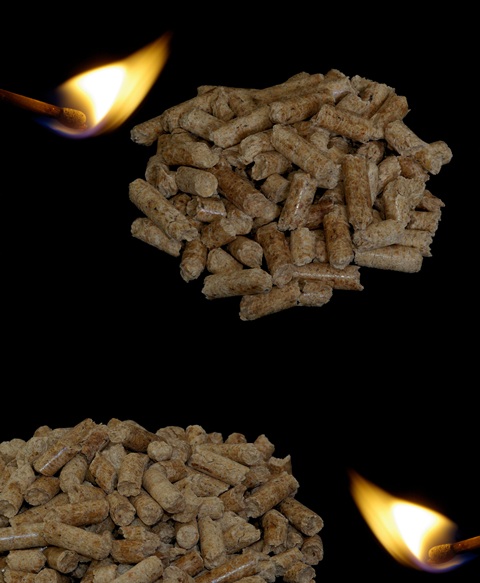
Overall wood energy accounts for 3.4% of the total primary energy supply and 38.9% of the renewable energy supply in 27 UNECE member countries[1] in 2011, confirming its role as the leading source of renewable energy. And around 40% of all mobilized woody biomass supply is used for energy purposes.
These are the main conclusions of the UNECE/FAO Joint Wood Energy Enquiry, a biennial questionnaire that aims to shed light on the real role of wood energy within the region by promoting cross-sectoral communication and cooperation between the energy and forestry sectors. Now in its fourth round since 2005, the Enquiry has become a reference source of information on wood energy, drawing responses from an increasing number of countries. Preliminary results for the 2011 round were released yesterday in Geneva at the annual session of the UNECE/FAO Working Party on Forest Statistics Economics and Management.
Share of wood energy in renewable energy supply, 2011 (percentage)
Note: BiH = Bosnia and Herzegovina.
Main trends
It was possible to identify trends in the use of wood energy and to provide a comparison by selecting a subset of 11 countries that have responded to consecutive rounds of the enquiry.[2] Between 2009 and 2011, the amount of wood used for energy purposes within this group of countries grew annually by 4.8%. The role of wood in total primary energy supply increased slightly from 4.3% to 5.4% while the share of wood energy among renewable energy sources increased from 46.1% to 48.7%.
Share of wood energy in total primary energy supply, 2011 (percentage)
Note: BiH = Bosnia and Herzegovina.
Sources of wood energy
The main sources of wood energy were as follows:
- Co-products and residues[3] from forest-based industries, including processed wood fuels with improved energy content such as wood pellets, briquettes and charcoal (also called indirect sources) contributed 57%.
- Woody biomass from forests and other wooded land (also known as direct sources) such as logging residues, thinnings and clearings, which represented 34.1% of consumption.
- Recovered waste wood (mainly waste from construction, but also packaging and old furniture), which accounted for 3.7% of the supply.
However, the proportion of these sources varies among countries. For instance, Albania, Armenia, Bosnia and Herzegovina, France, Italy, Serbia and Slovenia rely heavily on direct supplies of wood fibres. But Austria, Canada, Finland, Ireland, Luxembourg, the Netherlands, Sweden and the United States rely mainly on wood supply from indirect sources.
Canada, Finland, Norway, Sweden and the United States have large shares of energy generated from black liquor,[4] reflecting the relative importance of the pulp and paper industries in the forest sector.
Waste wood is reported as a significant source of wood energy in Germany, the Netherlands and the United Kingdom, where it is mainly consumed in power applications and waste to energy plants. In general, however, data on recovered wood are difficult to obtain and often not discernible from overall waste statistics.
Uses of wood energy
Some 48% of the wood energy supply is consumed by the industrial sector. The forest products industry typically consumes energy generated from the solid and liquid co-products of its manufacturing processes. Countries with major forest industries, such as Finland, Sweden and the United States, have therefore a higher level of industrial consumption.
Residential use, mainly dependent on direct supplies of firewood, accounted for 34.4% of the wood energy supply. Albania, Armenia, Bosnia and Herzegovina, Romania, Serbia, Slovenia and Ukraine report this category as their primary use.
But consumption of wood energy use by private households is often higher than official records indicate. The power and heat sector represents 15% of wood energy use. This sector is the largest consumer of wood energy in Denmark, the Netherlands and the United Kingdom.
Further information is available at www.unece.org/forests/jwee.html
For any additional comments or questions, please contact:
David Ellul
UNECE/FAO Forestry and Timber Section
Tel: +41 (0)22 917 1390
E-mail: [email protected]
Website: http://www.unece.org/forests
Note to editors:
The Joint Wood Energy Enquiry was developed in collaboration with the International Energy Agency and Eurostat to address the need for a specialized dataset on wood energy. Wood energy statistics are often concealed within statistics on energy from renewables and waste, and are only available in energy units. The Enquiry provides data in units that are readily understandable by the forestry sector, thus enabling a direct comparison between the material and energy uses of woody biomass. It collects data on several streams of woody biomass supply, providing valuable information on national and international wood flows.
[1] The Enquiry was sent out all the UNECE member states (except Andorra, Monaco and San Marino). The following 24 countries provided data: Albania, Armenia, Austria, Bosnia and Herzegovina, Cyprus, Czech Republic, Denmark, Estonia, Finland, France, Germany, Iceland, Ireland, Luxembourg, Netherlands, Norway, Poland, Serbia, Slovenia, Sweden, Switzerland, Ukraine, United Kingdom and United States. In addition, data for a further 3 countries, Canada, Italy and Romania, were estimated by the secretariat based on IEA 2010 data.
[3] These co-products can be solid (e.g. sawdust, chips, slabs) or liquid (e.g. black liquor or tall oil).
[4] Black liquor is the liquid material remaining from pulpwood cooking in the papermaking process.



